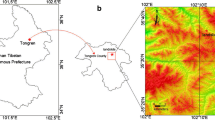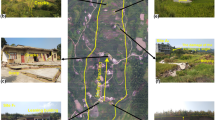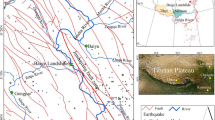Abstract
A large-scale obliquely inclined bedding rockslide, activated by a heavy rainstorm, occurred on July 8, 2020, at 7:05 (UTC + 8) in Shiban Village, Songtao Miao Autonomous County, Guizhou Province, China. The loss of life in this event was greatly reduced owing to the local warning system for rainstorm-induced geohazards. To understand the failure characteristics, triggering factors, the genetic mechanism of the landslide, the geomorphological features, geological characteristics, hydrological conditions, and rainfall characteristics were systematically studied by a synthetic approach including field investigations, satellite imagery, unmanned aerial vehicle (UAV) photography, laboratory tests, and rainfall data statistics. The results indicated that the interface between the soft and hard rock, the well-developed joints, and the free face in front of the slope constituted the boundaries of this landslide. The concave topography at the back and southern edge of the landslide, the bare ground, and the cataclastic structure of the rock mass provided favorable conditions for the collection or infiltration of rainwater. The concentrated rainstorm was the direct trigger for the landslide, which led to a rapid inflow and retention of rainfall in the landslide through favorable landform and geological conditions. The groundwater recharge that cannot be drained in time caused the mechanical deterioration of rock mass and induced a rapid increase in pore water pressure in the landslide. Moreover, the water level of the Ganlong River at the toe of the slope also rose rapidly, and the uplift pressure in front of the slope increased accordingly. Under the combined action of these adverse factors, the overall anti-sliding force of the slope was less than the sliding force, finally resulting in the landslide. Remarkably, the local warning system for rainstorm-induced geohazards successfully forecasted the landslide, but the shortcoming is that the forecast time in advance is short. Nevertheless, the prediction has significantly reduced human casualties and provided valuable experience for the prediction of this type of landslide.









Similar content being viewed by others
References
Cen DF, Huang D, Ren F (2017) Shear deformation and strength of the interphase between the soil-rock mixture and the benched bedrock slope surface. Acta Geotech 12(2):391–413. https://doi.org/10.1007/s11440-016-0468-2
Cogan J, Gratchev I, Wang GH (2018) Rainfall-induced shallow landslides caused by ex-tropical cyclone Debbie, 31st March 2017. Landslides 15(6):1215–1221. https://doi.org/10.1007/s10346-018-0982-4
Criss RE, Yao WM, Li CD, Tang HM (2020) A predictive, two-parameter model for the movement of reservoir landslides. J Earth Sci 31(6):1051–1057. https://doi.org/10.1007/s12583-020-1331-9
Cruden DM, Martin CD (2009) A century of risk management at the Frank Slide, Canada, in Culshaw MG, Reeves HJ, Jefferson I, and Spink TW, eds. Engineering geology for tomorrow’s cities: geological society of London Special Publication 22, paper 772 (CD-ROM)
Cui P, Peng JB, Shi PJ, Tang HM, Ouyang CJ, Zou Q, Liu LY, Li CD, Lei Y (2021) Scientific challenges of research on natural hazards and disaster risk. Geogr Environ Sustain 2:216–223. https://doi.org/10.1016/j.geosus.2021.09.001
Dang K, Sassa K, Konagai K et al (2019) Recent rainfall-induced rapid and long-traveling landslide on 17 May 2016 in Aranayaka, Kagelle District, Sri Lanka. Landslides 16:155–164. https://doi.org/10.1007/s10346-018-1089-7
Fernández O, Muñoz JA, Arbués P (2003) Quantifying and correcting errors derived from apparent dip in the construction of dip-domain cross-sections. J Struct Geol 25(1):35–42.https://doi.org/10.1016/S0191-8141(02)00020-2
GB/T 28592–2012 (2012) Grade of precipitation. Beijing: China standard press pp 1–2 (in Chinese)
Gu DM, Huang D, Yang WD, Zhu JL, Fu GF (2017) Understanding the triggering mechanism and possible kinematic evolution of a reactivated landslide in the Three Gorges Reservoir. Landslides 14:2073–2087. https://doi.org/10.1007/s103-017-0845-4
Guo J, Xu M, Zhang Q, Xiao XX, Zhang SS, He SM (2020) Reservoir regulation for control of an ancient landslide reactivated by water level fluctuations in Heishui River, China. J Earth Sci 31(6):1058–1067. https://doi.org/10.1007/s12583-020-1341-7
Highland LM, Schuster RL (2000) Significant landslide events in the United States. USGS, Retrieved from http://landslide.usgs.gov/docs/faq/significantls_508.pdf,2000. Accessed 25 Aug 2021
Hu K, Wu CH, Tang JB, Alessandro P, Li YJ, Yan SX (2018) New understandings of the June 24th 2017 Xinmo Landslide, Maoxian, Sichuan, China. Landslides 15:2465–2474. https://doi.org/10.1007/s10346-018-1073-2
Li CD, Fu ZY, Wang Y, Tang HM, Yan JF, Gong WP, Yao WM, Criss RE (2019) Susceptibility of reservoir-induced landslides and strategies for increasing the slope stability in the Three Gorges Reservoir Area: Zigui Basin as an example. Eng Geol 261:105279. https://doi.org/10.1016/j.enggeo.2019105279
Li CD, Long JJ, Liu Y, Li Q, Liu WQ, Feng PF, Li BC, Xian JY (2021a) Mechanism analysis and partition characteristics of a recent highway landslide in Southwest China based on a 3D multi-point deformation monitoring system. Landslides p. 1–12. https://doi.org/10.1007/s10346-021-01698-2
Li CD, Criss RE, Fu ZY, Long JJ, Tan QW (2021b) Evolution characteristics and displacement forecasting model of landslides with stair-step sliding surface along the Xiangxi River, Three Gorges Reservoir region. China Eng Geol 283
Li WC, Dai FC, Wei YQ, Wang ML, Min H, Lee LM (2016) Implication of subsurface flow on rainfall-induced landslide: a case study. Landslides 13(5):1109–1123. https://doi.org/10.1007/s10346-015-0619-9
Lin F, Wu LZ, Huang RQ, Zhang H (2018) Formation and characteristics of the Xiaoba landslide in Fuquan, Guizhou, China. Landslides 15(4):669–681. https://doi.org/10.1007/s10346-017-0897-5
Lee S, Pradhan B (2007) Landslide hazard mapping at Selangor, Malaysia using frequency ratio and logistic regression models. Landslides 4(1):33–41. https://doi.org/10.1007/s10346-006-0047-y
Ma G, Hu X, Yin Y et al (2018) Failure mechanisms and development of catastrophic rockslides triggered by precipitation and open-pit mining in Emei, Sichuan, China. Landslides 15:1401–1414. https://doi.org/10.1007/s10346-018-0981-5
Müller SL (1964) The rock slide in the Vaiont Valley. Rock Mech Eng Geol 2(3–4):148–212
Ouyang CJ, Zhou KQ, Xu Q, Yin JH, Peng DL, Wang DP, Li WL (2017) Dynamic analysis and numerical modeling of the 2015 catastrophic landslide of the construction waste landfill at Guangming, Shenzhen, China. Landslides 14(2):705–718. https://doi.org/10.1007/s10346-016-0764-9
Qi SW, Lan HX, Dong JY (2015) An analytical solution to slip buckling slope failure triggered by earthquake. Eng Geol 194:4–11. https://doi.org/10.1016/j.enggeo.2014.06.004
Staehli M, Sättele M, Huggel C, McArdell BW, Lehmann P, Van Herwijnen A, Or D (2015) Monitoring and prediction in early warning systems for rapid mass movements. Nat Hazard 15(4):905–917. https://doi.org/10.5194/nhess-15-905-2015
T/CMSA 0013–2019 (2019) The grade of rainfall in short time weather service. Public Meteorological Service Center of China Meteorological Administration pp 1–3 (in Chinese)
Tang HM, Wasowski J, Juang CH (2019) Geohazards in the Three Gorges Reservoir Area, China – lessons learned from decades of research. Eng Geol 261:105267. https://doi.org/10.1016/j.enggeo.2019.105267
Tang HM, Zou ZX, Xiong CR, Wu YP, Hu XL, Wang LQ, Lu S, Criss RE, Li CD (2015) An evolution model of large consequent bedding rockslides, with particular reference to the Jiweishan rockslide in Southwest China. Eng Geol 186:17–27. https://doi.org/10.1016/j.enggeo.2014.08.021
Toll DG (2001) Rainfall-induced landslides in Singapore. Proc Inst Civ Eng Geotech Eng 149(4):211–216. https://doi.org/10.1680/geng.2001.149.4.211
Wang FW, Zhang YM, Huo ZT, Tatsunori M, Huang BL (2004) The July 14, 2003 Qianjiangping landslide, Three Gorges Reservoir, China. Landslides 1:157–162. https://doi.org/10.1007/s10346-004-0020-6
Wu M, Pi XW, Wu XY, Liu H, Ma LY (2020) Analysis on meteorological causes and meteorological service of landslide disaster in Songtao County. J Agric Sci Technol 24:172–173+177. https://doi.org/10.1007/57399(2020)24-0172-02
Xu GL, Li WN, Yu Z, Ma XH, Yu ZZ (2015) The 2 September 2014 Shanshucao landslide, Three Gorges Reservoir China. Landslides 12(6):1169–1178. https://doi.org/10.1007/s10346-015-0652-8
Xue DM, Li TB, Zhang S, Ma CC, Gao MB, Liu J (2018) Failure mechanism and stabilization of a basalt rock slide with weak layers. Eng Geol 233:213–224. https://doi.org/10.1016/j.enggeo.2017.12.005
Yao WM, Li CD, Zuo QJ, Zhan HB, Criss RE (2019) Spatiotemporal deformation characteristics and triggering factors of Baijiabao landslide in Three Gorges Reservoir region, China. Geomorphology 343:34–47. https://doi.org/10.1016/j.geomorph.2019.06.024
Yin YP (2013) Investigation on catastrophic landslide of January 11, 2013 at Zhaojiagou, Zhenxiong County. Yunnan Province Eng Geol 21(1):6–15
Yin YP, Sun P, Zhang M, Li B (2011) Mechanism on apparent dip sliding of oblique inclined bedding rockslide at Jiweishan, Chongqing, China. Landslides 8(1):49–65. https://doi.org/10.1007/s10346-010-0237-5
Yu HB, Li CD, Zhou JQ, Chen WQ, Long JJ, Wang XT, Peng T (2020) Recent rainfall and excavation-induced bedding rockslide on 22 October 2018 in Jian-En expressway, Hubei, China. Landslides 17:2619–2629. https://doi.org/10.1007/s10346-020-01468-6
Zhang XY (1972) 1:200000 geological map H4925 (Sichuan Province) data. Sichuan Geological Bureau 107 Geological Team. Retrieved from http://www.ngac.org.cn/Map/Document?guid=EC7E1A7A7C1A1954E0430100007F182E. Accessed 28 Sep 2021
Zhao LH, Li DJ, Tan HH, Cheng X, Zuo S (2019) Characteristics of failure area and failure mechanism of a bedding rockslide in Libo County, Guizhou, China. Landslides 16(7):1367–1374. https://doi.org/10.1007/s10346-019-01188-6
Zhao LH, Zuo S, Deng DP, Han Z, Zhao B (2018) Development mechanism and parameter inversion analysis for landslides: a case study of the landslide at Xinlu Village, Chongqing, China. Landslides 15(10):2075–2081. https://doi.org/10.1007/s10346-019-01188-6
Funding
This work was supported by the National Natural Science Fund of China (42090054, 41922055, 51909247, and 41931295), the National Key R&D Program of China (2018YFC1507200), the Key Research and Development Program of Hubei Province of China (2020BCB079), and the Fundamental Research Funds for the Central Universities, China University of Geosciences (Wuhan) (CUGGC09).
Author information
Authors and Affiliations
Corresponding author
Ethics declarations
Conflict of interest
The authors declare no competing interests.
Rights and permissions
About this article
Cite this article
Yu, H., Li, C., Zhou, JQ. et al. A large-scale obliquely inclined bedding rockslide triggered by heavy rainstorm on the 8th of July 2020 in Shiban Village, Guizhou, China. Landslides 19, 1119–1130 (2022). https://doi.org/10.1007/s10346-022-01850-6
Received:
Accepted:
Published:
Issue Date:
DOI: https://doi.org/10.1007/s10346-022-01850-6




